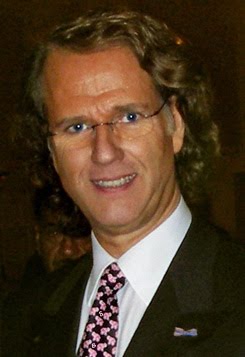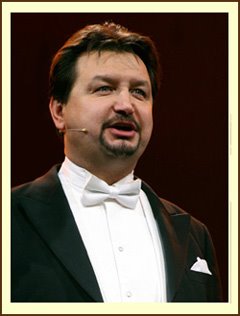A Chapter From The
Book
"Rieu, Maestro Without Borders"
INTERVIEW WITH GOSHA TARNOWSKI
"Rieu, Maestro Without Borders"
INTERVIEW WITH GOSHA TARNOWSKI
André himself selects the fabrics. He likes beautiful clothes and historical costumes. Whenever we make a new dress, we also take into account what the wearer would like. For a dress that would be crucial to a performance, such as the one for soloist Carla Maffioletti, we purchase ten times as much fabric as is needed, and then André decides what he finds most suitable. The color of the dress should compliment the personality of the person.
A dress needs six meters of fabric. We do not use silk, because it doesn’t wash well. Satin is better. The clothing must be durable, because it will be subjected to a lot of packing and unpacking. If we – no matter where - find exceptionally beautiful dresses anywhere which are particularly well suited for someone, we will purchase them. They must have classic allure, radiate wealth and breathe historic atmosphere. André has a vision in his head; he really visualizes an image, and we attempt to approach that.
 When designing, we also have to take into account the changing of costumes. That
often needs to happen quickly. A soloist may have to change costumes four times
within the same performance and that also means four different sets of matching
shoes and jewelry. Fortunately I’m not prone to stress. Sometimes a zipper
breaks on stage and then you have to solve the problem within a minute, often quickly stitching it up
and then figure out how to repair it permanently and properly later. All that matters is that it looks good on stage … ‘The show must go on’.
When designing, we also have to take into account the changing of costumes. That
often needs to happen quickly. A soloist may have to change costumes four times
within the same performance and that also means four different sets of matching
shoes and jewelry. Fortunately I’m not prone to stress. Sometimes a zipper
breaks on stage and then you have to solve the problem within a minute, often quickly stitching it up
and then figure out how to repair it permanently and properly later. All that matters is that it looks good on stage … ‘The show must go on’. The costumes have changed over the years. The dresses used to have a more common style, with large puff sleeves. The fabrics used to be more lustrous and colorful and often even had a opalescent sheen. That was followed by a transitional period, with lots of embroidery and ‘old-fashioned’ designs. Today the costumes are more modern. They have also become more expensive: a dress takes 120 work hours to make, which, together with the cost of the fabric, represents a cost of three-and-a-half thousand Euros. The decorations and rhinestones are sewn on by hand.
We have an excellent seamstress in our team and two embroiderers. Every
lady in the Orchestra has four dresses. We have the entire outfits in four-fold,
including the instruments. So do the math: fifteen thousand Euros per female
orchestra member. But through those dresses our orchestra is not a boring black
and white scenario like other orchestras. We also have beautiful little jackets, because
it can be cold and the ladies have plunging necklines.
The men’s outfits are not as labor intensive – ha-ha – but they too have four tuxedos each (tailcoats), which we buy from tailors who do customized sewing. They cost twelve hundred Euros each. The tuxedos have also been modernized over the years. Adjustments are made to ensure a perfect fit whenever someone loses or picks up some weight. The suit has to fit well, has to breathe and allow for ease of movement, a cellist for instance needs sleeves that allow for big movements which are essential when playing that instrument.
I start each concert at eight o'clock with the makeup for the tenors. Many of the ladies do that themselves, but the men there are less skillful in that. After the show I am still busy for a long time, packing, laundering shirts. The men's shirts have to be washed after every performance, but I like doing that. They must always look pristine when on stage."
 Information about the book:
Dutch title: Rieu, Maestro Zonder Grenzen. Available in
Dutch only. Authors: Maaike Meijer, Peter Peters, Jac.
van den Boogard. Publisher: De Bezige
Bij and can be ordered at ► Bol.com
Information about the book:
Dutch title: Rieu, Maestro Zonder Grenzen. Available in
Dutch only. Authors: Maaike Meijer, Peter Peters, Jac.
van den Boogard. Publisher: De Bezige
Bij and can be ordered at ► Bol.com
The men’s outfits are not as labor intensive – ha-ha – but they too have four tuxedos each (tailcoats), which we buy from tailors who do customized sewing. They cost twelve hundred Euros each. The tuxedos have also been modernized over the years. Adjustments are made to ensure a perfect fit whenever someone loses or picks up some weight. The suit has to fit well, has to breathe and allow for ease of movement, a cellist for instance needs sleeves that allow for big movements which are essential when playing that instrument.
I start each concert at eight o'clock with the makeup for the tenors. Many of the ladies do that themselves, but the men there are less skillful in that. After the show I am still busy for a long time, packing, laundering shirts. The men's shirts have to be washed after every performance, but I like doing that. They must always look pristine when on stage."
Translation by John (USA) and Entia (South Africa) - We thank
the Publisher for their permission to translate this for The Harmony Parlor
 Information about the book:
Dutch title: Rieu, Maestro Zonder Grenzen. Available in
Dutch only. Authors: Maaike Meijer, Peter Peters, Jac.
van den Boogard. Publisher: De Bezige
Bij and can be ordered at ► Bol.com
Information about the book:
Dutch title: Rieu, Maestro Zonder Grenzen. Available in
Dutch only. Authors: Maaike Meijer, Peter Peters, Jac.
van den Boogard. Publisher: De Bezige
Bij and can be ordered at ► Bol.com




































































































































4 comments:
Very interesting, thank you so much for the beautiful translation, and thanks to the publisher for allowing the translation! I saw the costume exhibition up close in the Museum on the Vrijthof, and the costumes are so beautifully made. The detail and craftsmanship is outstanding, with hand-sewn beads, trim, embroidery etc. No wonder they look so wonderful onstage!
Thanks again,
Jennifer D.
Thank you. Much appreciated.
Thank you for this translation. Always very interesting to read something from Andre's "behind the scenes". Saw the Exhibition in The Museum this year and when you see the dresses up-close, you can appreciate how beautifully made they are and why they always look so exquisite on stage.
Moira x
Very interesting to read articles from "Behind the scenes". I never knew that they took washing machines on tour and it was an eye opener for me to read how expensive the gowns and tuxedos are! Andre only goes for the best!
Ineke.
Post a Comment